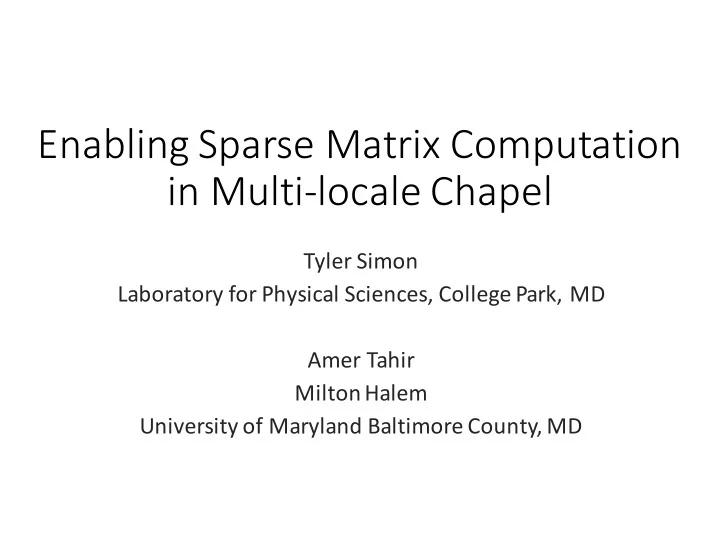

Enabling Sparse Matrix Computation in Multi-locale Chapel Tyler Simon Laboratory for Physical Sciences, College Park, MD Amer Tahir Milton Halem University of Maryland Baltimore County, MD
Mo Motivation, Objectives & Related Work rk Motivation Aims Ø “To provide a data structure in the Chapel Ø Large sparse matrices often appear in Science or programming language that enables the Engineering problems, Social Network analysis, implementation of CG benchmark for Topic modeling, Graph analytics, Sentiment compressed large sparse matrices” analysis, Cyber security and so on. Ø Chapel programming language currently unable to deal with distributed compressed/sparse matrices Ø Storage and processing of these matrices is not over multiple locales. possible on a single computer, so high Ø This work develops MSBD, a Multilocale Sparse performance computing (HPC) systems are used. Block Distribution for Chapel. Ø HPC systems are evaluated with benchmarks. Related Work Conjugate Gradient algorithm on sparse matrices Ø HPCG & NASCG is used in popular HPC benchmarks, HPCG and • Sequential, OpenMP and MPI reference NAS CG. implementations Ø Chapel port of NAS CG - uses CSR Ø Chapel, an emerging PGAS (partitioned global • Single-locale only – Doesn’t scale to multiple address space) language built for parallel nodes! computation offers flexibility and abstraction – Ø Unified Parallel C (UPC) and Titanium significantly less lines of code compared to • UPC implementation offers better speed than existing solutions (MPI/OpenMP). MPI but doesn’t scale as well as MPI based matrix multiplication
MS MSBD Overv rview • Proposed solution is a custom Chapel distribution for sparse matrices • Behaves like Block distribution but only non-zeros stored locally at compute nodes in Coordinate format (COO) – matrix values as [i, j, x], where x is the non- zero at row i and column j in the sparse matrix • Local-to-global mapping of indices and values done at each node as a communication optimization
MS MSBD Overv rview MSBD distributes sparse matrix by partitioning it over nodes: 1, 1, 3.0 1, 3, 1.0 1, 4, 2.0 Node 1 Node 2 2, 2, 4.0 3, 2, 7.0 3, 3, 5.0 4, 9.0 Node 3 Node 4 4, 6.0 4, 6.0 4, 5.0 4, 5.0 5, 7.0 Assigned to locales Sparse matrix Non-zeros in block partitions • Sparse matrix is mapped into fixed boundary partitions to locales • Sparse matrix values are accessed/modified only when required – reduces extra communication overhead
Evaluation Ev • MSBD evaluated by using NAS CG algorithm in Chapel • Sparse matrix A is a synthetic positive definite square matrix of 4% sparseness where each element ∈ (0.0, 1.0) • CG algorithm consists of 25 iterations • At the end of iterations, final result is compared with predefined values given in NAS CG benchmark for error • Multi-locale CG algorithm that uses MSDB is run parallel on varying number of nodes, 1 – 10. Multiple tests are done each for different size of the matrix, 14000, 50000 and 100000. The objective is to show scalability of the proposed MSBD.
Re Results
Co Conclusion • This work presents a generalized multi-locale sparse block distribution for Chapel, MSBD • MSBD partitions 2-D sparse data into blocks compressed in COO format that are assigned to nodes in the cluster • Using a Chapel NAS CG algorithm, MSBD is evaluated on UMBC’s Bluewave cluster and shown to be scalable
Contact tasimon@lps.umd.edu
Recommend
More recommend